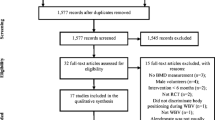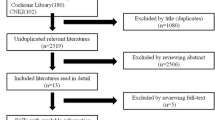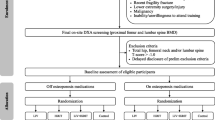Abstract
The present study observed significant effects of whole-body vibration (WBV) on bone mineral density (BMD) in postmenopausal women, with high-quality evidence for high-frequency, low-magnitude, and high-cumulative-dose use. The aim was to update a previous systematic review with meta-analysis to observe the effects of WBV on BMD in postmenopausal women. For the meta-analysis, the weighted mean difference between WBV and control groups, or WBV and conventional exercise, was used for the area of bone mineral density (aBMD) of the lumbar spine, femoral neck, total hip, trochanter, intertrochanter, and Ward’s area, or volumetric trabecular bone mineral density (vBMDt) of the radius and tibia. Methodological quality was assessed using the PEDro scale and the quality of evidence using the GRADE system. In total, 23 studies were included in the systematic review and 20 in the meta-analysis. Thirteen studies showed high methodological quality. WBV compared with control groups showed significant effects on aBMD in the primary analysis (lumbar spine and trochanter), sensitivity (lumbar spine), side-alternating vibration (lumbar spine and trochanter), synchronous vibration (lumbar spine), low frequency and high magnitude (lumbar spine and trochanter), high frequency and low magnitude (lumbar spine), high frequency and high magnitude (lumbar spine, trochanter, and Ward’s area), high cumulative dose and low magnitude (lumbar spine), low cumulative dose and high magnitude (lumbar spine and trochanter), and positioning with semi-flexed knees (trochanter). Of these results, only high frequency associated with low magnitude and high cumulative dose with low magnitude showed high-quality evidence. At this time, considering the high quality of evidence, it is possible to recommend WBV using high frequency (≈ 30 Hz), low magnitude (≈ 0.3 g), and high cumulative dose (≈ 7000 min) to improve lumbar spine aBMD in postmenopausal women. Other parameters, although promising, need to be better investigated, considering, when applicable, the safety of the participants, especially in vibrations with higher magnitudes (≥ 1 g).



Similar content being viewed by others
References
Rajapakse CS, Johncola AJ, Batzdorf AS, Jones BC, Mukaddam MA, Sexton K (2021) Effect of low-intensity vibration on bone strength, microstructure, and adiposity in pre-osteoporotic postmenopausal women: a randomized placebo-controlled trial. J Bone Miner Res 36:673–684. https://doi.org/10.1002/jbmr.4229
Sen EI, Esmaeilzadeh S, Eskiyurt N (2020) Effects of whole-body vibration and high impact exercises on the bone metabolism and functional mobility in postmenopausal women. J Bone Miner Metab 38:392–404. https://doi.org/10.1007/s00774-019-01072-2
ElDeeb AM, Abdel-Aziem AA (2020) Effect of whole-body vibration exercise on power profile and bone mineral density in postmenopausal women with osteoporosis: a randomized controlled trial. J Manipulative Physiol Ther 43:384–393. https://doi.org/10.1016/j.jmpt.2019.12.003
Oliveira LC, Oliveira RG, Pires-Oliveira DAA (2019) Effects of whole-body vibration versus pilates exercise on bone mineral density in postmenopausal women: a randomized and controlled clinical trial. J Geriatr Phys Ther 42:E23–E31. https://doi.org/10.1519/JPT.0000000000000184
Jepsen DB, Ryg J, Hansen S, Jørgensen NR, Gram J, Masud T (2019) The combined effect of Parathyroid hormone (1–34) and whole-body Vibration exercise in the treatment of postmenopausal Osteoporosis (PaVOS study): a randomized controlled trial. Osteoporos Int 30:1827–1836. https://doi.org/10.1007/s00198-019-05029-z
Marín-Cascales E, Rubio-Arias JA, Alcaraz PE (2019) Effects of two different neuromuscular training protocols on regional bone mass in postmenopausal women: a randomized controlled trial. Front Physiol 10:846–854. https://doi.org/10.3389/fphys.2019.00846
Marín-Cascales E, Alcaraz PE, Rubio-Arias JA (2017) Effects of 24 weeks of whole body vibration versus multicomponent training on muscle strength and body composition in postmenopausal women: a randomized controlled trial. Rej Res 20:193–201. https://doi.org/10.1089/rej.2016.1877
Santin-Medeiros F, Santos-Lozano A, Rey-López JP, Garatachea N (2015) Effects of eight months of whole body vibration training on hip bone mass in older women. Nutr Hosp 31:1654–1659. https://doi.org/10.3305/nh.2015.31.4.8441
Liphardt AM, Schipilow J, Hanley DA, Boyd SK (2015) Bone quality in osteopenic postmenopausal women is not improved after 12 months of whole-body vibration training. Osteoporos Int 26:911–920. https://doi.org/10.1007/s00198-014-2995-8
Leung KS, Li CY, Tse YK, Choy TK, Leung PC, Hung VWY, Chan SY, Leung AHC, Cheung WH (2014) Effects of 18-month low-magnitude high-frequency vibration on fall rate and fracture risks in 710 community elderly - a cluster - randomized controlled trial. Osteoporos Int 25:1785–1795. https://doi.org/10.1007/s00198-014-2693-6
Slatkovska L, Beyene J, Alibhai SMH, Wong Q, Sohail QZ, Cheung AM (2014) Effect of whole-body vibration on calcaneal quantitative ultrasound measurements in postmenopausal women: a randomized controlled trial. Calcif Tissue Int 95:547–556. https://doi.org/10.1007/s00223-014-9920-1
Lai CL, Tseng SY, Chen CN, Liao WC, Wang CH, Lee MC, Hsu PS (2013) Effect of 6 months of whole body vibration on lumbar spine bone density in postmenopausal women: a randomized controlled trial. Clin Interv Aging 8:1603–1609. https://doi.org/10.2147/CIA.S53591
Stolzenberg N, Belavý DL, Beller G, Armbrecht G, Semler J, Felsenberg D (2013) Bone strength and density via pQCT in post-menopausal osteopenic women after 9 months resistive exercise with whole body vibration or proprioceptive exercise. J Musculoskelet Neuronal Interact 13:66–76
Karakiriou SK, Douda HT, Smilios IG, Volaklis KA, Tokmakidis SP (2012) Effects of vibration and exercise training on bone mineral density and muscle strength in post-menopausal women. Eur J Sport Sci 12:81–88. https://doi.org/10.1080/17461391.2010.536581
Slatkovska L, Alibhai SMH, Beyene J, Hu H, Demaras A, Cheung AM (2011) Effect of 12 months of whole-body vibration therapy on bone density and structure in postmenopausal women. A randomized trial Annals Intern Med 155:668–679. https://doi.org/10.7326/0003-4819-155-10-201111150-00005
Verschueren SMP, Bogaerts A, Delecluse C, Claessens AL, Haentjens P, Vanderschueren D, Boonen S (2011) The effects of whole-body vibration training and vitamin D supplementation on muscle strength, muscle mass, and bone density in institutionalized elderly women: a 6-month randomized, controlled trial. J Bone Miner Res 26:42–49. https://doi.org/10.1002/jbmr.181
Von Stengel S, Kemmler W, Bebenek M, Engelke K, Kalender WA (2011) Effects of whole-body vibration training on different devices on bone mineral density. ACSM 43:1071–1079. https://doi.org/10.1249/MSS.0b013e318202f3d3
Von Stengel S, Kemmler W, Engelke K, Kalender WA (2011) Effects of whole body vibration on bone mineral density and falls: results of the randomized controlled ELVIS study with postmenopausal women. Osteoporos Int 22:317–325. https://doi.org/10.1007/s00198-010-1215-4
Beck BR, Norling TL (2010) The effect of eight months of twice-weekly low or higher intensity whole body vibration on risk factors for postmenopausal hip fracture. Am J Phys Med Rehabil 89:997–1009. https://doi.org/10.1097/PHM.0b013e3181f71063
Gusi N, Raimundo A, Leal A (2006) Low-frequency vibratory exercise reduces the risk of bone fracture more than walking: a randomized controlled trial. BMC Musculoskelet Disord 7:92. https://doi.org/10.1186/1471-2474-7-9
Verschueren SMP, Roelants M, Delecluse C, Swinnen S, Vanderschueren D, Boonen S (2004) Effect of 6-month whole body vibration training on hip density, muscle strength, and postural control in postmenopausal women: a randomized controlled pilot study. J Bone Miner Res 19:352–359. https://doi.org/10.1359/JBMR.0301245
Rubin C, Recker R, Cullen D, Ryaby J, McCabe J, McLeod K (2004) Prevention of postmenopausal bone loss by a low-magnitude, high-frequency mechanical stimuli: a clinical trial assessing compliance, efficacy, and safety. J Bone Miner Res 19:343–351. https://doi.org/10.1359/JBMR.0301251
Russo CR, Lauretani F, Bandinelli S, Bartali B, Cavazzini C, Guralnik JM, Ferrucci L (2003) High-frequency vibration training increases muscle power in postmenopausal women. Arch Phys Med Rehabil 84:1854–1857. https://doi.org/10.1016/S0003-9993(03)00357-5
Slatkovska L, Alibhai SMH, Beyene J, Cheung AM (2010) Effect of whole-body vibration on BMD: a systematic review and meta-analysis. Osteoporos Int 21:1969–1980. https://doi.org/10.1007/s00198-010-1228-z
Oliveira LC, Oliveira RG, Pires-Oliveira DA (2016) Effects of whole body vibration on bone mineral density in postmenopausal women: a systematic review and meta-analysis. Osteoporos Int 27:2913–2933. https://doi.org/10.1007/s00198-016-3618-3
Teng GG, Curtis ER, Saag KG (2008) Mortality and osteoporotic fractures: is the link causal, and is it modifiable? Clin Exp Rheumatol 26:S125–S137
Rizzoli R (2018) Postmenopausal osteoporosis: assessment and management. Best Pract Res Clin Endocrinol Metab 32:739–757. https://doi.org/10.1016/j.beem.2018.09.005
Kemmler W, Shojaa M, Kohl M, Von Stengel S (2020) Effects of different types of exercise on bone mineral density in postmenopausal women: a systematic review and meta-analysis. Calcif Tissue Int 107:409–439. https://doi.org/10.1007/s00223-020-00744-w
Burton E, Hill AM, Pettigrew S, Lewin G, Bainbridge L, Farrier K, Airey P, Hill KD (2017) Why do seniors leave resistance training programs? Clin Interv Aging 12:585–592. https://doi.org/10.2147/CIA.S128324
Van Heuvelen M, Rittweger J, Judex S, Sañudo B, Seixas A, Fuermaier A, Tucha O, Nyakas C, Marín PJ, Taiar R, Stark C, Schoenau E, Sá-Caputo DC, Bernardo-Filho M, Van der Zee EA (2021) Reporting guidelines for whole-body vibration studies in humans, animals and cell cultures: a consensus statement from an international group of experts. Biology 10:965. https://doi.org/10.3390/biology10100965
Rauch F, Sievanen H, Boonen S, Cardinale M, Degens H, Felsenberg D, Roth J, Schoenau E, Verschueren S, Rittweger J (2010) Reporting whole-body vibration intervention studies: recommendations of the International Society of Musculoskeletal and Neuronal Interactions. J Musculoskelet Neuronal Interact 10:193–198
Ozcivici E, Luu YK, Adler B, Qin Y, Rubin J, Judex S, Rubin CT (2010) Mechanical signals as anabolic agents in bone. Nat Rev Rheumatol 6:50–59. https://doi.org/10.1038/nrrheum.2009.239
Chen J, Ruan H, Liu Y, Bao J, Xu H, Yao M et al (2018) Therapeutic effects of whole-body vibration on fracture healing in ovariectomized rats: a systematic review and meta-analysis. Menopause 26:677–686. https://doi.org/10.1097/GME.0000000000001285
Minematsu A, Nishii Y, Sakata S (2021) Effects of whole-body vibration on bone properties in aged rats. J Musculoskelet Neuronal Interact 21:287–297
Minematsu A, Nishii Y, Imagita H, Sakata S (2019) Whole body vibration at low-frequency can increase trabecular thickness and width in adult rats. J Musculoskelet Neuronal Interact 19:169–177
Page MJ, McKenzie JE, Bossuyt PM, Boutron I, Hoffmann TC, Mulrow CD et al (2021) The PRISMA 2020 statement: an updated guideline for reporting systematic reviews. BMJ 372:n71. https://doi.org/10.1136/bmj.n71
Higgins JPT, Thomas J, Chandler J, Cumpston M, Li T, Page MJ, Welch VA (editors) (2021) Cochrane handbook for systematic reviews of interventions version 6.2. Cochrane. Available from www.training.cochrane.org/handbook(updated February 2021)
Maher CG, Moseley AM, Sherrington C, Elkins MR, Herbert RD (2008) A description of the trials, reviews and practice guidelines indexed in the PEDro database. Phys Ther 88:1068–1077. https://doi.org/10.2522/ptj.20080002
Maher CG, Sherrington C, Herbert RD, Moseley AM, Elkins M (2003) Reliability of the PEDro scale for rating quality of randomized controlled trials. Phys Ther 83:713–721
The Centre of Evidence-Based Physiotherapy (2012) Sydney Available from: http://www.pedro.org.au
Jadad AR, Moore RA, Carroll D, Jenkinson C, Reynolds DJ, Gavaghan DJ, McQuay HJ (1996) Assessing the quality of reports of randomized clinical trials: is blinding necessary? Control Clin Trials 17:1–12. https://doi.org/10.1016/0197-2456(95)00134-4
Verhagen AP, de Vet HC, de Bie RA, Kessels AG, Boers M, Bouter LM, Knipschild PG (1998) The Delphi list: a criteria list for quality assessment of randomized clinical trials for conducting systematic reviews developed by Delphi consensus. J Clin Epidemiol 51:1235–1241. https://doi.org/10.1016/S0895-4356(98)00131-0
Schünemann H, Brożek J, Guyatt G, Oxman A (2013) GRADE handbook. Available from: https://gdt.gradepro.org/app/handbook/handbook.html
Iwamoto J, Takeda T, Sato Y, Uzawa M (2005) Effect of wholebody vibration exercise on lumbar bone mineral density, bone turnover, and chronic back pain in post-menopausal osteoporotic women treated with alendronate. Aging Clin Exp Res 17:157–163
Iwamoto J, Takeda T, Sato Y, Uzawa M (2019) Retraction note to: Effect of whole-body vibration exercise on lumbar bone mineral density, bone turnover, and chronic back pain in post-menopausal osteoporotic women treated with alendronate. Aging Clin Exp Res 31:1855. https://doi.org/10.1007/s40520-019-01373-6
Fratini A, Bonci T, Bull AM (2016) Whole body vibration treatments in postmenopausal women can improve bone mineral density: results of a stimulus focussed meta-analysis. PLoS ONE 11:e0166774. https://doi.org/10.1371/journal.pone.0166774
Harazin B, Grzesik J (1998) The transmission of vertical whole-body vibration to the body segments of standing subjects. J Sound Vib 215:775–787. https://doi.org/10.1006/jsvi.1998.1675
Judex S, Rubin CT (2010) Is bone formation induced by high frequency mechanical signals modulated by muscle activity? J Musculoskelet Neuronal Interact 10:3–11
Howe TE, Shea B, Dawson LJ, Downie F, Murray A, Ross C, Harbour RT, Caldwell LM, Creed G (2011) Exercise for preventing and treating osteoporosis in postmenopausal women. Cochrane Database Syst Rev 6:CD000333. https://doi.org/10.1002/14651858.CD000333.pub2
Tang BM, Eslick GD, Nowson C, Smith C, Bensoussan A (2007) Use of calcium or calcium in combination with vitamin D supplementation to prevent fractures and bone loss in people aged 50 years and older: a meta-analysis. Lancet 370:657–666. https://doi.org/10.1016/S0140-6736(07)61342-7
Cranney A, Guyatt G, Griffith L, Wells G, Tugwell P, Rosen C, Osteoporosis Methodology Group and The Osteoporosis Research Advisory Group (2002) Meta-analyses of therapies for postmenopausal osteoporosis. IX: summary of meta-analyses of therapies for postmenopausal osteoporosis. Endocr Rev 23:570–578. https://doi.org/10.1210/er.2001-9002
Beck BR (2015) Vibration therapy to prevent bone loss and falls: mechanisms and efficacy. Curr Osteoporos Rep 13:381–389. https://doi.org/10.1007/s11914-015-0294-8
Judex S, Rubin CT (2010) Is bone formation induced by high-frequency mechanical signals modulated by muscle activity? J Musculoskelet Neuronal Interact 10:3–11
Muir J, Kiel DP, Rubin CT (2013) Safety and severity of accelerations delivered from whole body vibration exercise devices to standing adults. J Sci Med Sport 16:526–531
Spain L, Yang L, Wilkinson JM, McCloskey E (2021) Transmission of whole body vibration - comparison of three vibration platforms in healthy subjects. Bone 144:115802
Author information
Authors and Affiliations
Corresponding author
Ethics declarations
Conflict of interest
None.
Additional information
Publisher's note
Springer Nature remains neutral with regard to jurisdictional claims in published maps and institutional affiliations.
Supplementary Information
Below is the link to the electronic supplementary material.
Rights and permissions
Springer Nature or its licensor holds exclusive rights to this article under a publishing agreement with the author(s) or other rightsholder(s); author self-archiving of the accepted manuscript version of this article is solely governed by the terms of such publishing agreement and applicable law.
About this article
Cite this article
de Oliveira, R.D.J., de Oliveira, R.G., de Oliveira, L.C. et al. Effectiveness of whole-body vibration on bone mineral density in postmenopausal women: a systematic review and meta-analysis of randomized controlled trials. Osteoporos Int 34, 29–52 (2023). https://doi.org/10.1007/s00198-022-06556-y
Received:
Accepted:
Published:
Issue Date:
DOI: https://doi.org/10.1007/s00198-022-06556-y




